Static Thermal Coupling Factors in Multi-Finger Bipolar Transistors: Part II-Experimental Validation
Abstract
:1. Introduction
2. Model Extension for Structures with BEOL and Parameter Extraction
3. TCAD Simulation and Model Testing
4. Model Validation with Measurements
4.1. Structure with Only Shallow Trench
4.2. Structure with Shallow and Deep Trench
5. Conclusions
Author Contributions
Funding
Conflicts of Interest
References
- Sahoo, A.K.; Fregonese, S.; Weis, M.; Maneux, C.; Malbert, N.; Zimmer, T. Impact of back-end-of-line on thermal impedance in SiGe HBTs. In Proceedings of the International Conference on Simulation of Semiconductor Processes and Devices (SISPAD), Glasgow, UK, 3–5 September 2013; pp. 188–191. [Google Scholar]
- Magnani, A.; Sasso, G.; d’Alessandro, V.; Codecasa, L.; Rinaldi, N.; Aufinger, K. Advanced thermal resistance simulation of SiGe HBTs including backend cooling effect. In Proceedings of the International Workshop on Thermal Investigations of ICs and Systems (THERMINIC), Paris, France, 30 September–2 October 2015; pp. 1–5. [Google Scholar]
- Sahoo, A.K.; Fregonese, S.; Weiss, M.; Maneux, C.; Zimmer, T. A Scalable Model for Temperature Dependent Thermal Resistance of SiGe HBTs. In Proceedings of the Bipolar/BiCMOS Circuits and Technology Meeting (BCTM), Bordeaux, France, 30 September–3 October 2013; pp. 29–32. [Google Scholar] [CrossRef]
- Walkey, D.J.; Smy, T.J.; Marchesan, D.; Tran, H.; Schröter, M. A scalable thermal model for trench isolated bipolar devices. Solid-State Electron 2000, 44, 1373–1379. [Google Scholar] [CrossRef]
- Rieh, J.S.; Greenberg, D.; Liu, Q.; Joseph, A.J.; Freeman, G.; Ahlgren, D.C. Structure optimization of trench-isolated SiGe HBTs for simultaneous improvements in thermal and electrical performances. IEEE Trans. Electron Dev. 2005, 52, 2744–2752. [Google Scholar] [CrossRef]
- Chakravorty, A.; D’Esposito, R.; Balanethiram, S.; Frégonèse, S.; Zimmer, T. Analytic Estimation of Thermal Resistance in HBTs. IEEE Trans. Electron Dev. 2016, 63, 2994–2998. [Google Scholar] [CrossRef]
- Sahoo, A.K.; Fregonese, S.; Desposito, R.; Aufinger, K.; Maneux, C.; Zimmer, T. A geometry scalable model for nonlinear thermal impedance of trench isolated HBTs. IEEE Electron Dev. Lett. 2015, 36, 56–58. [Google Scholar] [CrossRef]
- D’Esposito, R.; Frégonèse, S.; Chakravorty, A.; Chevalier, P.; Céli, D.; Zimmer, T. Innovative SiGe HBT Topologies With Improved Electrothermal Behavior. IEEE Trans. Electron Dev. 2016, 63, 2677–2683. [Google Scholar] [CrossRef] [Green Version]
- D’Esposito, R.; Frégonèse, S.; Zimmer, T.; Chakravorty, A. Dedicated test-structures for investigation of the thermal impact of the BEOL in advanced SiGe HBTs in time and frequency domain. In Proceedings of the International Conference on Microelectronic Test Structures (ICMTS), Yokohama, Japan, 28–31 March 2016; pp. 28–31. [Google Scholar] [CrossRef]
- Dwivedi, A.; Chakravorty, A.; D’Esposito, R.; Sahoo, A.K.; Fregonese, S.; Zimmer, T. Effects of BEOL on self-heating and thermal coupling in SiGe multi-finger HBTs under real operating condition. Solid-State Electron 2016, 115, 1–6. [Google Scholar] [CrossRef]
- Gupta, A.; Nidhin, K.; Balanethiram, S.; Yadav, S.; Chakravorty, A.; Fregonese, S.; Zimmer, T. Static Thermal Coupling Factors in Multi-Finger Bipolar Transistors: Part I-Model Development. J. Electron. 2020, 9, 1333. [Google Scholar] [CrossRef]
- Balanethiram, S.; Chakravorty, A.; D’Esposito, R.; Fregonese, S.; Céli, D.; Zimmer, T. Accurate modeling of thermal resistance for on-wafer SiGe HBTs using average thermal conductivity. IEEE Trans. Electron Dev. 2017, 64, 3955–3960. [Google Scholar] [CrossRef] [Green Version]
- Chevalier, P.; Avenier, G.; Ribes, G.; Montagné, A.; Canderle, E.; Céli, D.; Derrier, N.; Deglise, C.; Durand, C.; Quémerais, T.; et al. A 55 nm triple gate oxide 9 metal layers SiGe BiCMOS technology featuring 320 GHz fT/370 GHz fmax HBT and high-Q millimeter-wave passives. In Proceedings of the 2014 IEEE International Electron Devices Meeting, San Francisco, CA, USA, 15–17 December 2014. [Google Scholar]
- Balanethiram, S.; Chakravorty, A.; D’Esposito, R.; Fregonese, S.; Zimmer, T. An improved scalable self-consistent iterative model for thermal resistance in SiGe HBTs. In Proceedings of the Bipolar/BiCMOS Circuits and Technology Meeting (BCTM), New Brunswick, NJ, USA, 25–27 September 2016; pp. 150–153. [Google Scholar] [CrossRef] [Green Version]
- Gao, G.B.; Ünlü, M.S.; Morkoc, H.; Blackburn, D.L. Emitter ballasting resistor design for, and current handling capability of AlGaAs/GaAs power heterojunction bipolar transistors. IEEE Trans. Electron Dev. 1991, 38, 185–196. [Google Scholar] [CrossRef]
- Synopsys, Inc. Sentaurus: Sentaurus Device User Guide; Release H-2013.03; Synopsys, Inc.: Mountain View, CA, USA, 2013. [Google Scholar]
- D’Esposito, R. Electro-Thermal Characterization, TCAD Simulations and Compact Modeling of Advanced SiGe HBTs at Device and Circuit Level. Ph.D. Thesis, University of Bordeaux, Talence, France, 2016. [Google Scholar]
- Balanethiram, S.; D’Esposito, R.; Chakravorty, A.; Fregonese, S.; Zimmer, T. Extraction of BEOL Contributions for Thermal Resistance in SiGe HBTs. IEEE Trans. Electron Dev. 2017, 64, 1380–1384. [Google Scholar] [CrossRef] [Green Version]
- Slack, G.A. Thermal conductivity of pure and impure silicon, silicon carbide, and diamond. J. Appl. Phys. 1964, 35, 3460–3466. [Google Scholar] [CrossRef]
- Lee, Y.; Hwang, G.S. Mechanism of thermal conductivity suppression in doped silicon studied with nonequilibrium molecular dynamics. Phys. Rev. B 2012, 86, 075202. [Google Scholar] [CrossRef] [Green Version]
- Nghiêm, T.T.; Saint-Martin, J.; Dollfus, P. Electro-thermal simulation based on coupled Boltzmann transport equations for electrons and phonons. J. Comput. Electron. 2016, 15, 3–15. [Google Scholar] [CrossRef] [Green Version]
- Lehmann, S.; Zimmermann, Y.; Pawlak, A.; Schroter, M. Characterization of the static thermal coupling between emitter fingers of bipolar transistors. IEEE Trans. Electron Dev. 2014, 61, 3676–3683. [Google Scholar] [CrossRef]
- Weiss, M.; Sahoo, A.K.; Maneux, C.; Fregonese, S.; Zimmer, T. Mutual thermal coupling in SiGe:C HBTs. In Proceedings of the Symposium on Microelectronics Technology and Devices (SBMicro), Curitiba, Brazil, 2–6 September 2013; pp. 1–4. [Google Scholar] [CrossRef]



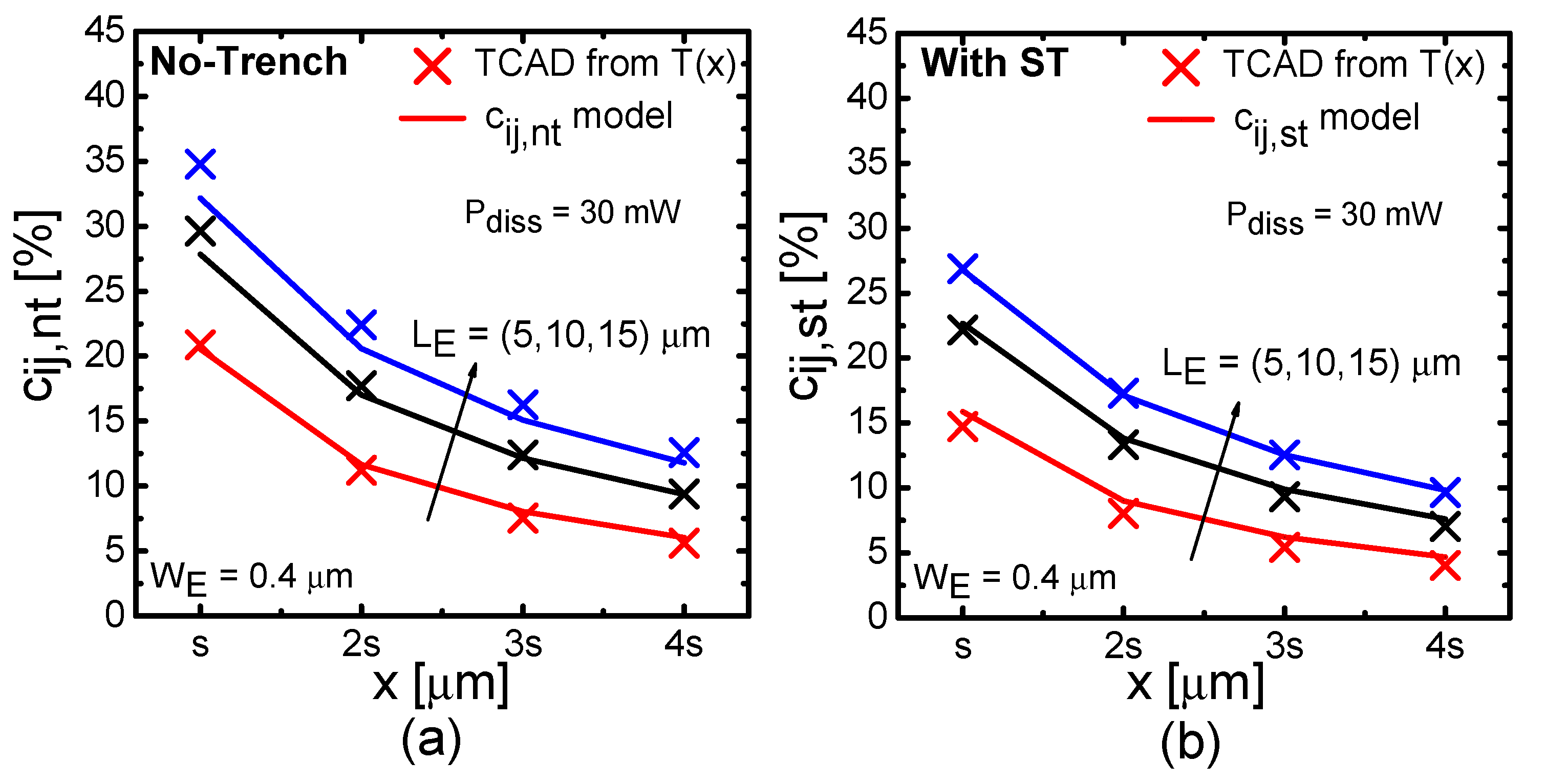
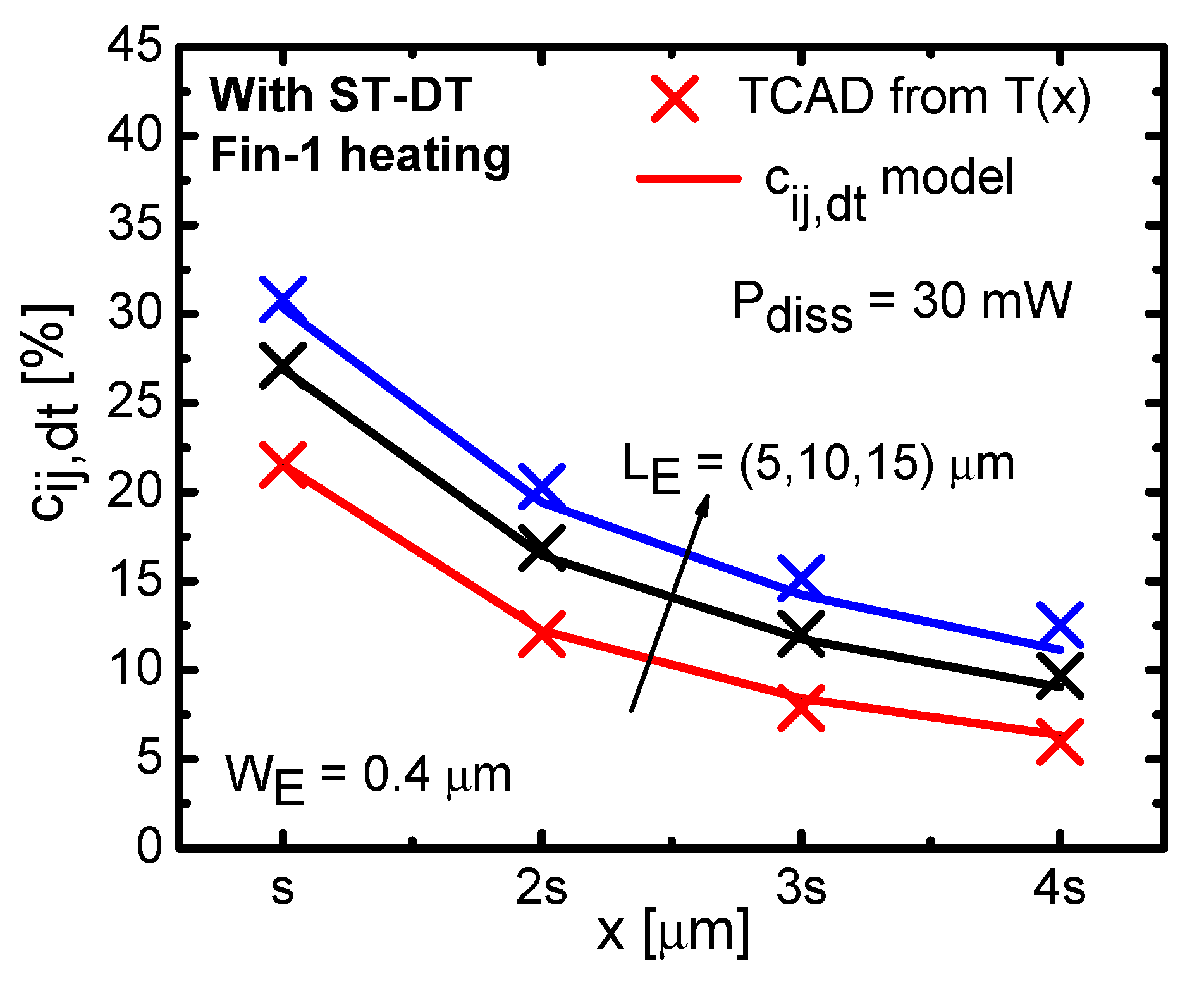
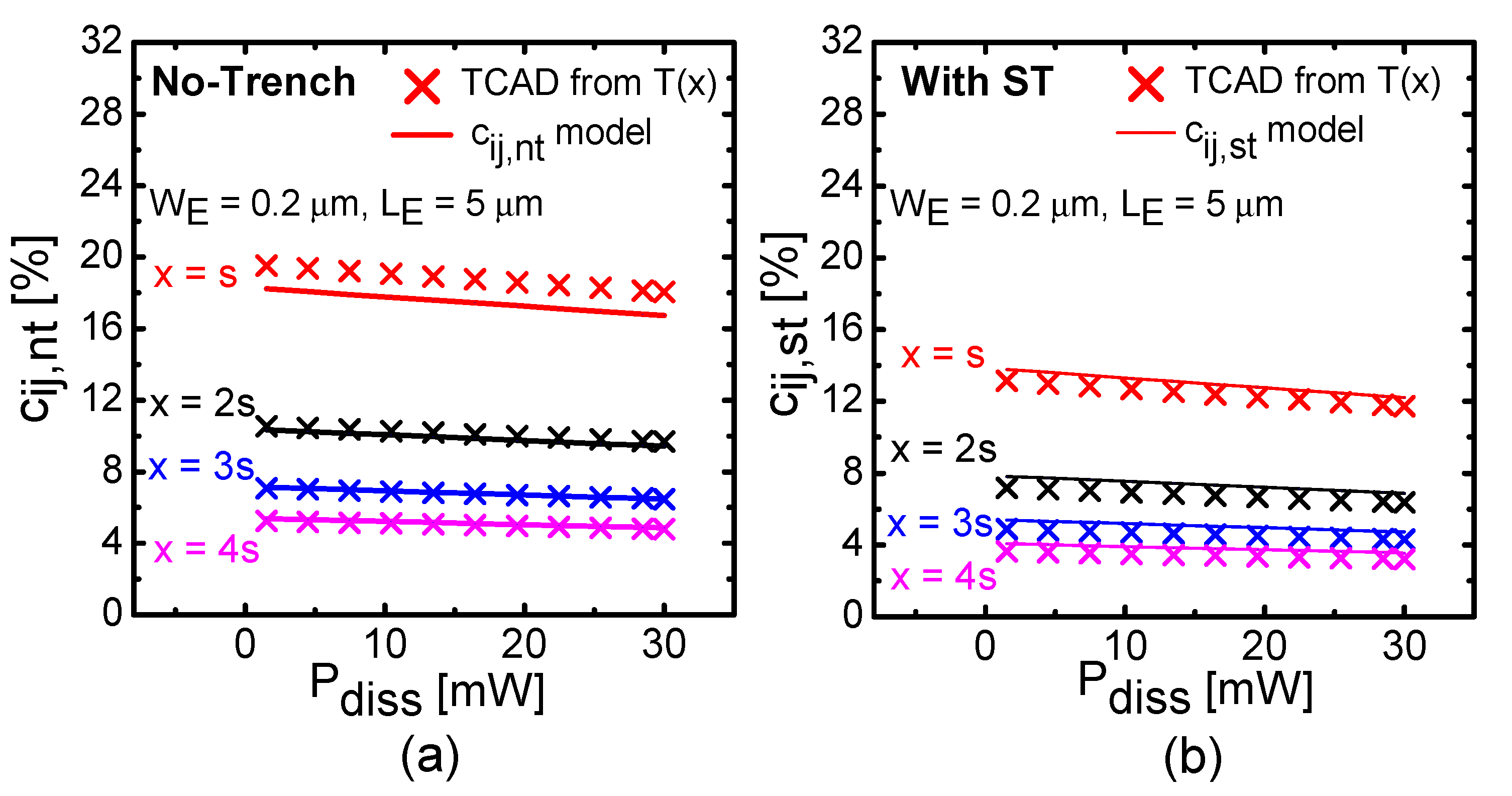

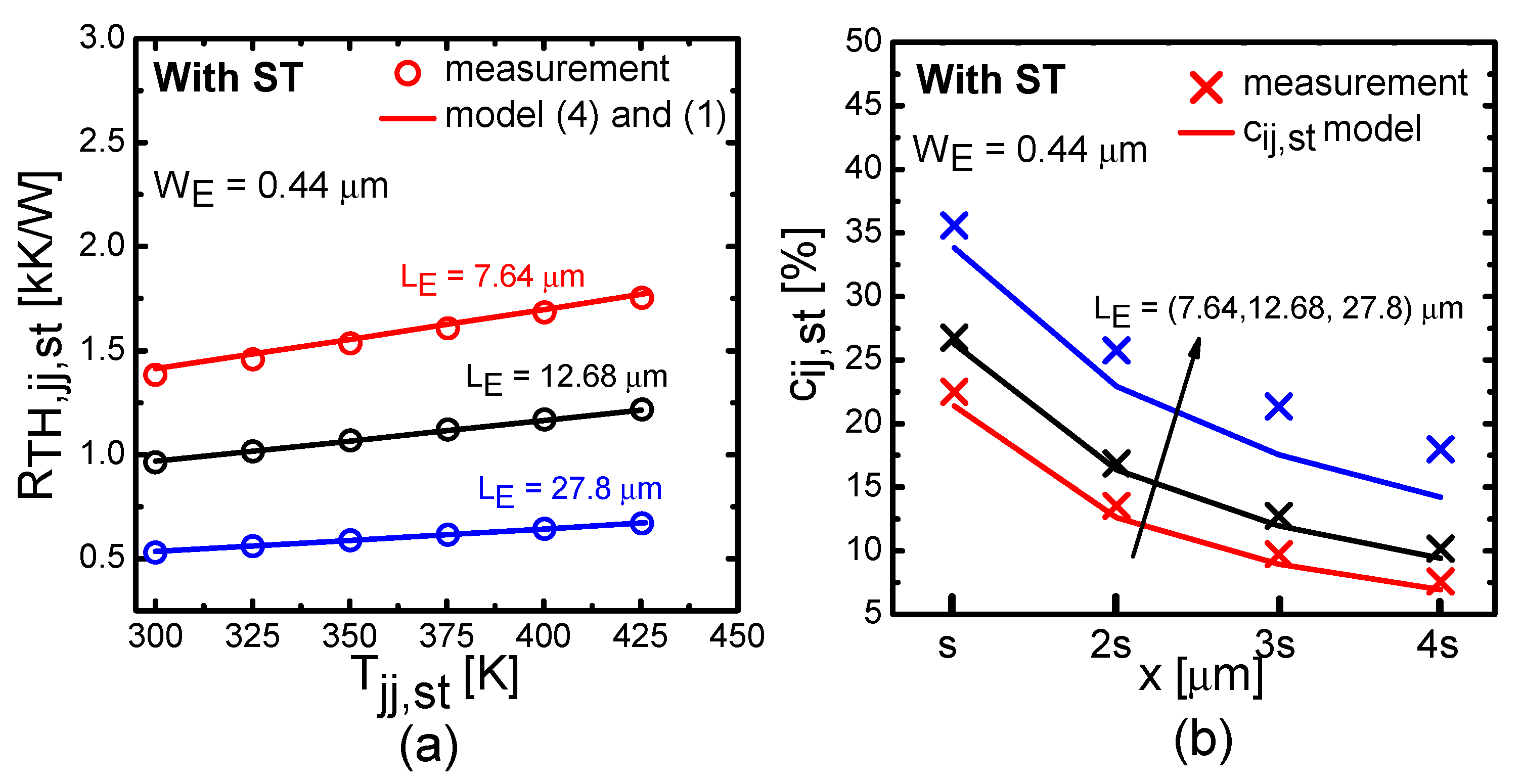

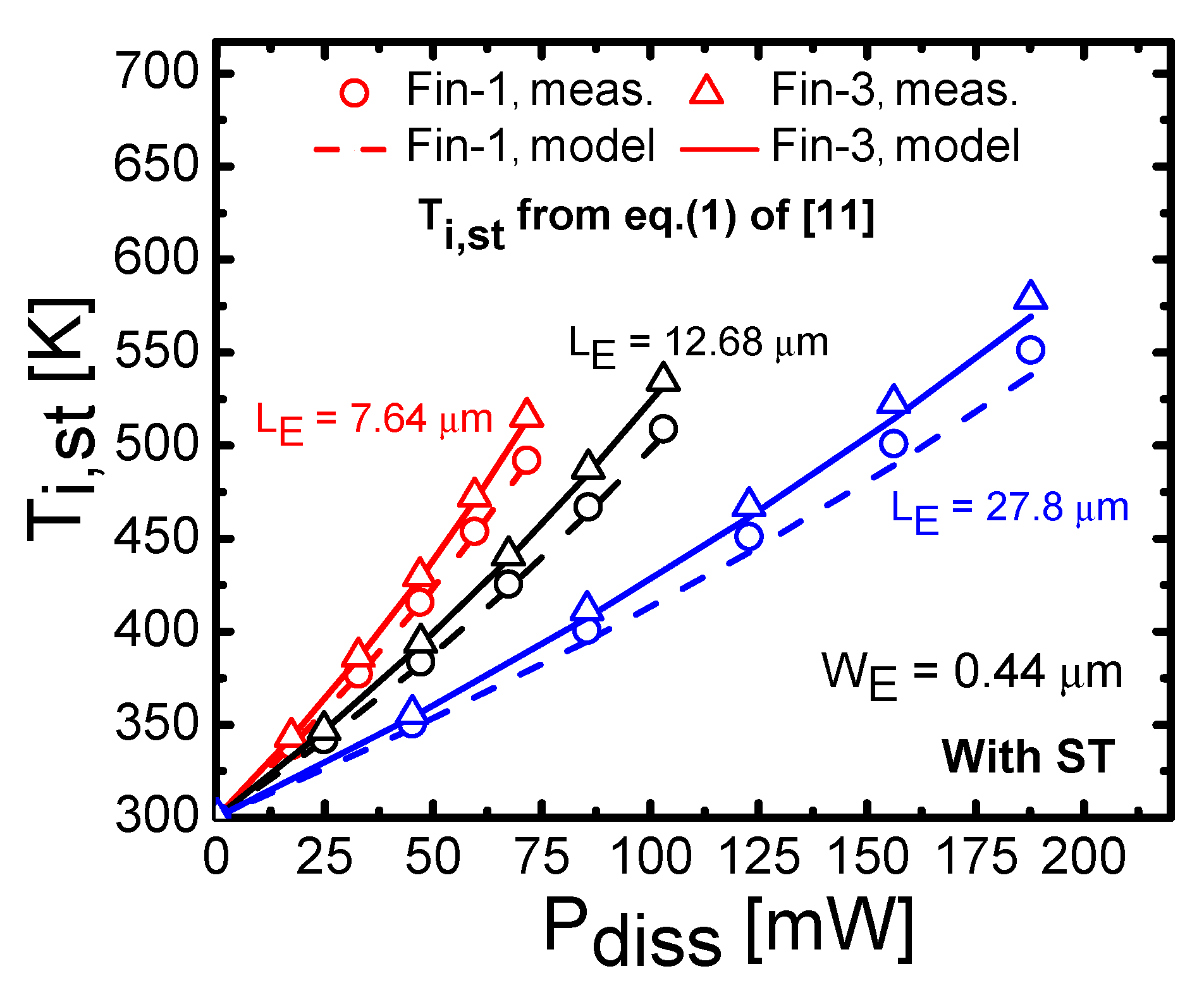
© 2020 by the authors. Licensee MDPI, Basel, Switzerland. This article is an open access article distributed under the terms and conditions of the Creative Commons Attribution (CC BY) license (http://creativecommons.org/licenses/by/4.0/).
Share and Cite
Gupta, A.; Nidhin, K.; Balanethiram, S.; Yadav, S.; Chakravorty, A.; Fregonese, S.; Zimmer, T. Static Thermal Coupling Factors in Multi-Finger Bipolar Transistors: Part II-Experimental Validation. Electronics 2020, 9, 1365. https://doi.org/10.3390/electronics9091365
Gupta A, Nidhin K, Balanethiram S, Yadav S, Chakravorty A, Fregonese S, Zimmer T. Static Thermal Coupling Factors in Multi-Finger Bipolar Transistors: Part II-Experimental Validation. Electronics. 2020; 9(9):1365. https://doi.org/10.3390/electronics9091365
Chicago/Turabian StyleGupta, Aakashdeep, K Nidhin, Suresh Balanethiram, Shon Yadav, Anjan Chakravorty, Sebastien Fregonese, and Thomas Zimmer. 2020. "Static Thermal Coupling Factors in Multi-Finger Bipolar Transistors: Part II-Experimental Validation" Electronics 9, no. 9: 1365. https://doi.org/10.3390/electronics9091365
APA StyleGupta, A., Nidhin, K., Balanethiram, S., Yadav, S., Chakravorty, A., Fregonese, S., & Zimmer, T. (2020). Static Thermal Coupling Factors in Multi-Finger Bipolar Transistors: Part II-Experimental Validation. Electronics, 9(9), 1365. https://doi.org/10.3390/electronics9091365






